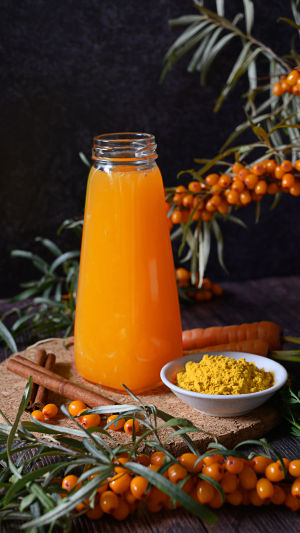Sea buckthorn is a plant, it is also known as sand date. Seabuckthorn is a perennial shrub or small tree commonly found in temperate and boreal regions of Asia, Europe, and North America.
Seabuckthorn plants are highly adaptable and able to grow in poor soils and harsh environmental conditions. Their root system helps to stabilize sand dunes and prevent wind erosion, so they play an important role in preventing desertification and soil retention.
Sea buckthorn fruits are one of the distinctive features of this plant. The orange-yellow or red fruit is rich in vitamin C, vitamin E, antioxidants, and other nutrients. Therefore, seabuckthorn fruit is widely used in food or as a nutritional supplement in health food and traditional herbal medicine.
In addition, sea buckthorn oil is also one of the important products of the sea buckthorn plant. Sea buckthorn oil extracted from sea buckthorn fruit is rich in fatty acids, especially unsaturated fatty acids such as linoleic acid and oleic acid. Seabuckthorn oil is widely used in the fields of the food industry, health products, and cosmetics.
Seabuckthorn has multiple functions, which cover the aspects of ecology, nutrition, and medicine. The main functions of sea buckthorn are as follows:
1. Ecological protection: seabuckthorn is a plant that has the function of windbreak and sand fixation. Its root system can stabilize sand dunes, prevent desertification and soil erosion, and thus play a positive role in protecting the ecological environment.
2. Nutritious: sea buckthorn fruit is rich in vitamin C, vitamin E, vitamin A, vitamin K, vitamin B complex, antioxidants, amino acids and minerals, and other nutrients. Therefore, seabuckthorn fruit is regarded as a food with high nutritional value.
3. Immune Enhancement: Due to being rich in vitamin C and antioxidants, sea buckthorn fruit is considered to be beneficial to the immune system, which can strengthen the body's immunity and help fight diseases.
4. Cardiovascular health care: unsaturated fatty acids such as linoleic acid and oleic acid in seabuckthorn fruits can help lower cholesterol levels, which is beneficial to cardiovascular health.
5. Anti-inflammation and anti-inflammation: Seabuckthorn has anti-inflammatory and anti-inflammatory effects, which are helpful to relieve discomfort caused by inflammation.
6. Skin care and moisturizing: Seabuckthorn oil is widely used in cosmetics and skin care products because it has good moisturizing and moisturizing effects and can improve dry skin problems.
7. Medical application: Seabuckthorn is used in traditional medicine to treat some diseases, such as indigestion, cold, gastritis, ulcer, and so on.
8. Health products: Sea buckthorn fruit and sea buckthorn oil are often made into health products and nutritional supplements for human consumption or external use.
It should be pointed out that although seabuckthorn has many benefits, individual groups, especially those with allergies or drug sensitivities, need to be cautious when eating or using seabuckthorn products.
The fruit of sea buckthorn is edible, and the oil is used for seasoning and cooking. Here are some common ways to eat sea buckthorn:
Eat raw: Ripe sea buckthorn fruit can be eaten raw directly. Note that sea buckthorn fruit has a certain sour taste, so if you don't like sour food, you can choose other cooking methods.
Juice: Squeeze the sea buckthorn fruit to make sea buckthorn juice, you can add some water and honey to adjust the taste. This is a simple and easy way to eat.
Making jam: Use sea buckthorn fruit to make jam, adding sugar and lemon juice can make the jam more delicious. You can spread the jam on bread or scones or as a topping for desserts.
Sea buckthorn oil seasoning: Sea buckthorn oil is extracted from sea buckthorn fruit, it has rich nutrition and unique flavor. You can use sea buckthorn oil in green salads, as a bread dip, or as a seasoning for a variety of dishes.
Dessert making: Seabuckthorn fruit is used to make desserts such as cakes, cookies, pies, etc., adding a special fruity aroma and color to food.
Matching with other ingredients: seabuckthorn fruit can be eaten with other fruits, yogurt, ice cream, etc., to increase the taste and nutrition of the food.
No matter which method of consumption you choose, make sure the sea buckthorn is ripe and non-toxic. In addition, because seabuckthorn has a certain sour taste, some people may not be suitable for eating it raw or in large quantities, so it is best to eat it in moderation to avoid discomfort. If you are trying sea buckthorn for the first time, it is recommended to taste a small amount first to ensure that you have no allergies or adverse reactions.





